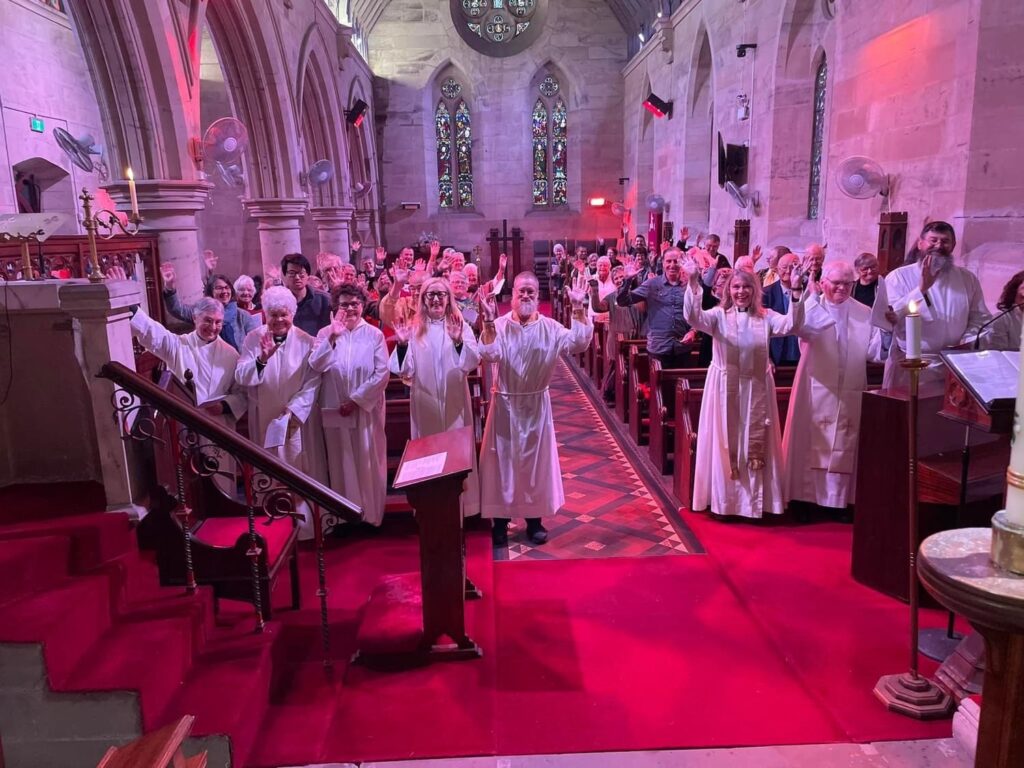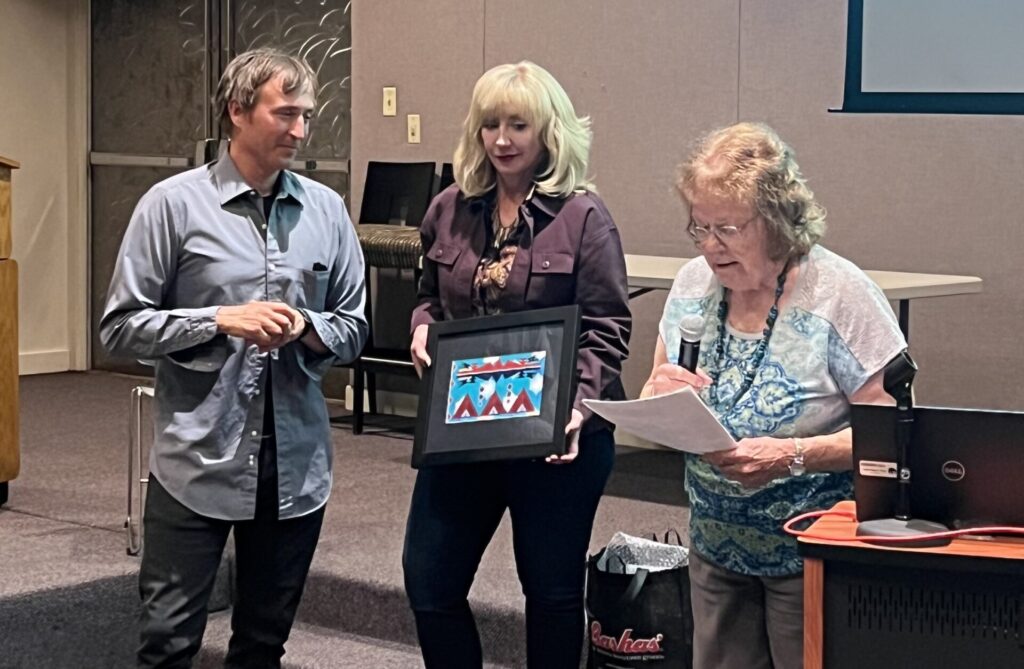(November 30, 2023)—Boozhoo (“hello” in Ojibwemowin), I am Ashleigh Thompson, an enrolled member of the Red Lake Ojibwe Nation. I work as Director of Tribal Collaboration in Research and Education at Archaeology Southwest. Helping form the cyberSW Tribal Working...
(November 30, 2023)—Boozhoo (“hello” in Ojibwemowin), I am Ashleigh Thompson, an enrolled member of the Red Lake Ojibwe Nation. I work as Director of Tribal Collaboration in Research and Education at Archaeology Southwest.
Helping form the cyberSW Tribal Working Group (TWG) was one of my first tasks when I started working at Archaeology Southwest (ASW) in early 2022. The cyberSW team wanted to convene a group of Indigenous advisors who could guide the database’s ongoing development.
Based on recommendations from the ASW research team and my network of Native people who work in cultural resources, I contacted members of Southwestern Tribes to ask if they were interested in joining the TWG. Seven people agreed to serve. Currently, the group’s members represent the Hopi Tribe, Navajo Nation, Salt River Pima-Maricopa Indian Community, Gila River Indian Community, Southern Ute Indian Tribe, White Mountain Apache Tribe, Caddo Nation, and Ohkay Owingeh communities.
The cyberSW TWG meets once a month on Zoom with the cyberSW research team. The group has been invaluable in determining what types of data to add to cyberSW, how to frame our Native American Fellowship position (now filled by Caitlynn Mayhew), and the answer to questions such as, “Who is this database for?” and “How do we make it relevant to Native people?” Many accomplishments have resulted from the TWG meetings. One of my favorites is adding a modern Tribal Lands layer to the database, so cyberSW users can see where Native Nations lay in relation to archaeological data within cyberSW.
It is of the utmost importance to include Indigenous Peoples in research that involves their cultural heritage. I look forward to seeing what additional input the TWG provides the research team. Lastly, I am grateful for the Tribal Working Group’s time, energy, and thoughtfulness in this endeavor. Chi miigwech (big thanks)!
What follows are some reflections on the TWG’s and cyberSW team’s collaboration over the past year and a half, as well as what they are excited about in the near future. We asked each commenter to consider the following questions:
(For TWG members)
» What initially drew you to joining the Tribal Working Group?
» Now that you have been a part of the Tribal Working Group for 1.5 years, what has been your experience?
» What improvements to cyberSW have you seen? What improvements do you hope to see in the future?
» Is there anything else you would like to share about your experience as part of the TWG?
(For staff members)
» How has the TWG led to the current version of cyberSW?
» How has collaborating with the TWG affected your work in areas outside of cyberSW?
» When you look back on the past two years of the cyberSW and TWG collaboration, what stands out the most?
» Looking forward, what does the TWG and the CyberSW team have to look forward to?
» Is there anything else you’d like to share about collaborating with the TWG?
Raquel Romero—Gila River Indian Community
I work for my Tribe as a cartographer/land surveyor for the Cultural Resource Management Program. My department is responsible for recording and managing historic and prehistoric sites within the Community. I have a background in archaeology and somewhere along the line fell into GIS work, which I really enjoy. Favorite parts of my job include working outside, working with landscape data, and having the opportunity to see historic areas in the Community.
While pursuing a graduate degree, I knew there was a lack of Natives working in archaeology. When asked to join the TWG, it sounded like a great opportunity because there were local Tribal members as well as ASW staff working together to better understand cultural sensitivity as relates to prehistoric data. I also saw this as a great opportunity to meet other Native professionals working in the field, as well as represent my Community.
I am impressed by ASW’s ongoing work. They have been receptive and respectful to all concerns raised by the TWG members. I know these critiques may at times be hard to hear, yet the staff members have met these concerns with the willingness to do and be better. I have also found it interesting to work with other TWG members because we are all so different. We come from different communities and backgrounds and that is reflected in our perspectives and opinions.
In terms of improvements, an experience that has left the biggest impression on me is when the two-year paid internship was created to work full-time on this project. Originally, ASW staff proposed that an academic degree be part of the requirements for whoever applied, but TWG members raised the concern that a degree was not necessary for a Tribal member who may come from a traditional background or have community-based knowledge. Requiring a degree would automatically disqualify a large pool of applicants who may be interested and able to contribute to the group. After a group discussion, the cyberSW internship was advertised as only requiring a high-school diploma. I consider this one example of how having a TWG creates understanding and broadens perspective for all individuals involved.
I have enjoyed being part of the TWG. We have pretty great discussions about what we find significant to add to the cyberSW database, such as plants, animals, and making the data relevant and accessible for people of all ages. I look forward to seeing how this group will evolve over time and the final product that comes from this work.
Lyle Balenquah—Hopi Tribe
I am a member of the Tep’ngyam or Greasewood Clan from Paaqavi Village on Third Mesa. I have worked as a field archaeologist and consultant for more than two decades, advocating for the protection and preservation of ancestral landscapes. I also work as an Outdoor Guide, leading river and backpacking trips across the Southwest.
I’ve been associated with ASW for a few years now, including serving as a board member for a time. As an organization, they have always impressed me with their efforts to engage their Indigenous partners in the research they conduct. I’ve maintained a working relationship with the organization and staff, and when the opportunity to join the TWG arose, I was happy to do so. Through my participation, I wanted to learn more about the cyberSW database, as well as collaborate with other Indigenous Archaeologists in developing Tribal-specific uses of that information.
I have had a positive experience working with the group, learning about the database, and with other Tribal members and hearing their perspectives about the various issues we encounter in archaeology, data sovereignty, and cultural preservation.
The recent addition of Caitlynn Mayhew, through a paid, two-year internship, is definitely a step in the right direction, and I look forward to working with her in this role. We’ve also added new members to the TWG, and I feel we have a well-rounded group with a diversity of skills and experiences. I think this will help the group in developing ways that the Tribes can utilize the database beyond archaeological purposes.
This could include projects such as documenting Cultural Landscapes (geographic place names and the events that occurred there), redefining archaeological categories according to Tribal knowledge, and developing educational curriculum to assist in the teaching of Tribal histories.
It is very encouraging to see the number of Indigenous Archaeologists and scientists continue to grow and increase our presence within these fields! The TWG is a reflection of that movement, and serves as a model for Tribes seeking new ways to incorporate science and technology within community-based research.
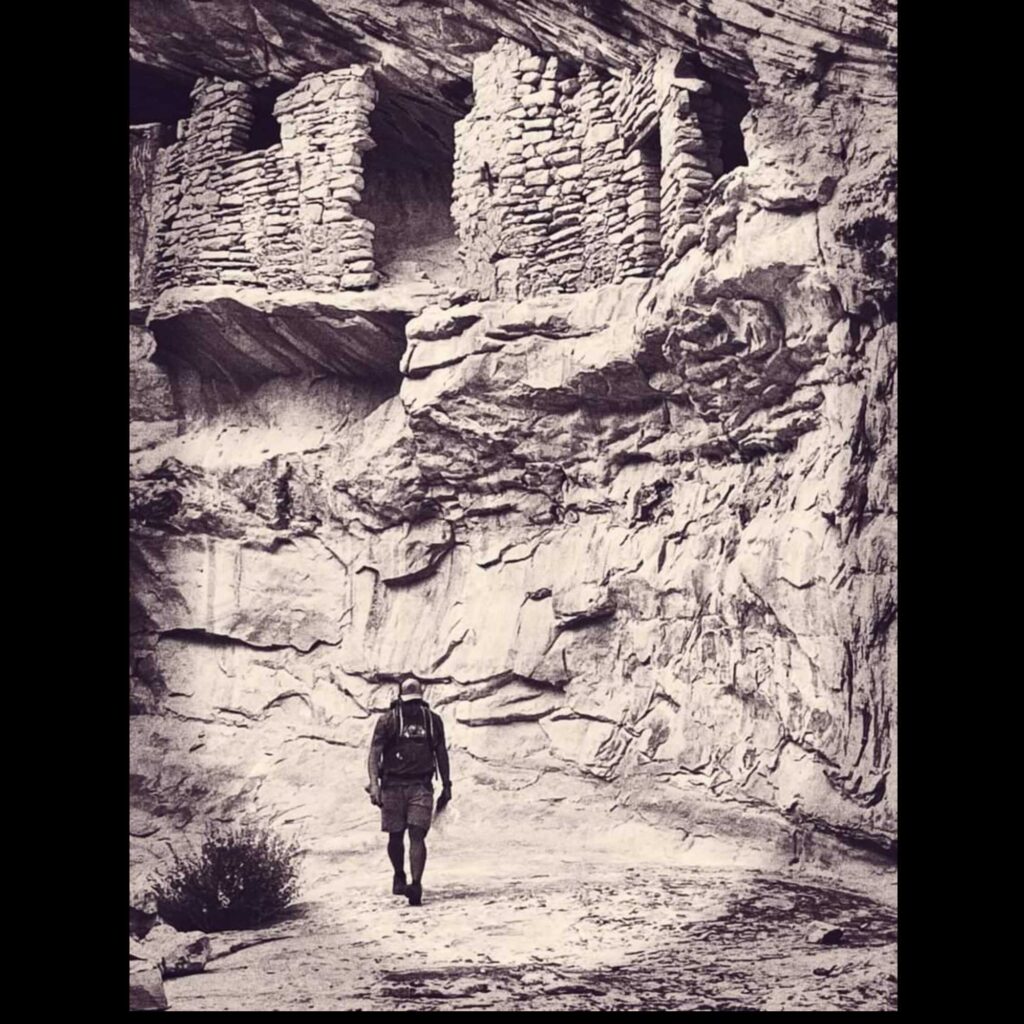 Lyle Balenquah. Image: Autry Lomahongva
Lyle Balenquah. Image: Autry Lomahongva
Garrett W. Briggs—Southern Ute Indian Tribe
Maykh—Nu nay neé ya Garrett W. Briggs. Nu kapuuta, moghwachi, murukachi. Hello, my name is Garrett W. Briggs. I am descendant from the kapuuta and moghwachi bands of Ute and of am Scottish and Irish descent.
I pursued an undergraduate and graduate degree in Archaeology with the goal of learning how non-native scholars studied and classified Indigenous people with the intent of returning to the Southern Ute Indian Tribe to learn about my community and culture, as well as assist in culture preservation. I began my professional journey working for my Tribe as a NAGPRA Coordinator Apprentice and later hired as the Tribal Historic Preservation Officer. Currently, I am employed by the United States Forest Service as the Assistant Regional Tribal Relations Program Manager for Region 3 (also known as the Southwest Region).
After following the development of cyberSW over the years, I was excited to accept an invitation to join the Tribal Working Group. Although the development of cyberSW was going in a positive and helpful direction academically, I felt it lacked Native American input regarding the type of data being collected and utilized. Therefore, by joining TWG, it was an opportunity to bring forth ideas and voice my concerns, as well as collaborate with TWG to enhance existing protocol and procedures that may influence the future management and use of the database.
I felt compelled to advocate for a more culturally diverse database that incorporated the archaeological and cultural knowledge of Native Nations not previously included. As a citizen of the Southern Ute Indian Tribe and Indigenous archaeologist, I wanted to ensure that non-sedentary or semi-sedentary Tribes, such as the Ute and Apache, were not missing in the database. By including this information, a more encompassing database and a better representation of Indigenous diversity could be made available.
My experience working with TWG has been inspiring and educational. Although I have not been able to be as involved as I planned, I am thankful for the continued communication provided by cyberSW and the opportunity to participate when my schedule permits. The professional character of and the collaboration between cyberSW and TWG has and will continue to result in positive enhancements to the program, which will advance the contextual understanding of spatial and cultural relationships between sites, current Tribal communities, ecological life zones, traditional cultural knowledge, and ancestral territories. Tuvuchi toghoyaqh.
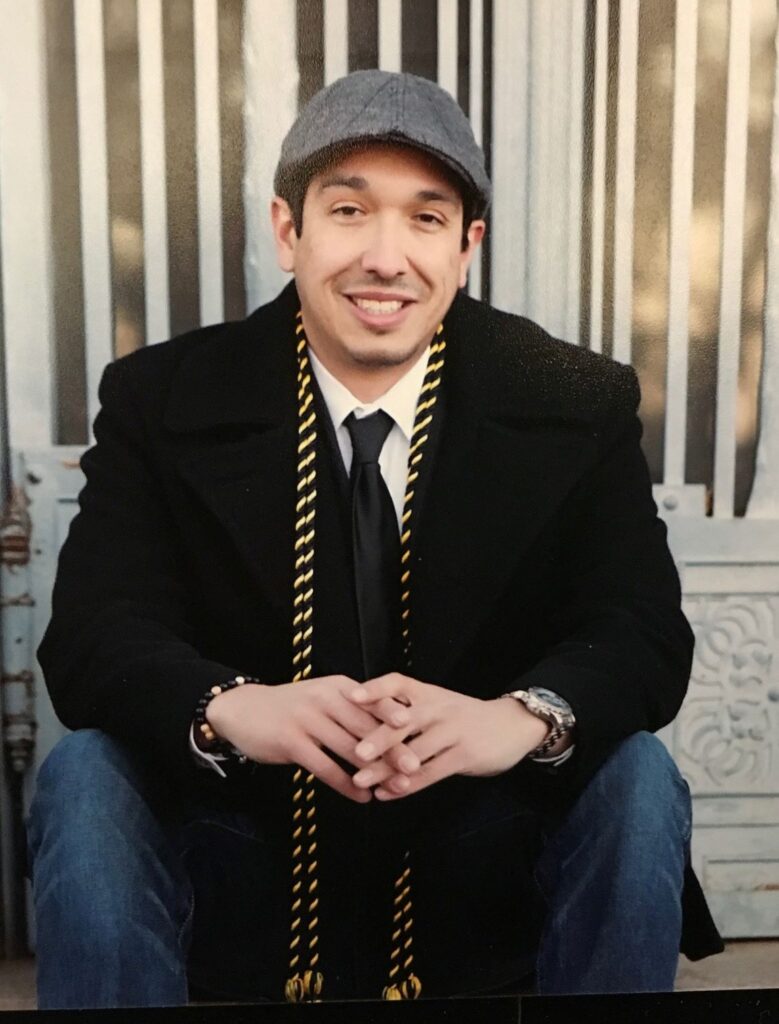 Garrett W. Briggs.
Garrett W. Briggs.
April Sewequaptewa—Hopi Tribe
I belong to the Butterfly clan and am from the village of Sichomovi on First Mesa. I graduated with my bachelor’s degree in History from Northern Arizona and started my journey into archaeology in 2000 by washing artifacts. I then worked for 18 years as a professional archaeologist in the private sector, focusing on laboratory management. From there, I moved to state agency work, initially with the Arizona State Land Department. I currently work as a historic planner for the Arizona Department of Transportation.
I was invited by fellow TWG member Lyle Balenquah to bring in a female point of view. My career as an Indigenous woman archaeologist was very lonely. However, I have always advocated for Indigenous people working in archaeology. I have always looked for ways to include Indigenous opinions regarding how our history is portrayed within science and history, so this seemed like a perfect opportunity to be able to do that.
My experience with the TWG since joining has been very fulfilling. To hear many different opinions and thoughts is what makes the meetings worth showing up for. We all have different experiences, but a common goal.
Regarding improvements, I have seen a shift in how data are used. I think it’s important for Indigenous people to feel safe in the science world, and if we can have a little bit of influence in how the information is released, that is a step in the right direction.
I hope we can expand to include more Tribes. We all have something to contribute. It is a good reminder of the work we still need to do to get more Indigenous people interested in archaeology.
Wade Campbell—Navajo Nation (Diné)
Ya’at’ééh—Wade Campbell yinishye. Kinyaa’áanii nish?i dóó bilagáana bashishchiin. Tó’áhaní dashicheii adóó bilagáana dashinálí. I’m currently an assistant professor of anthropology and archaeology at Boston University. My family hails from the community of Kits’iilí on Black Mesa and I grew up in the Window Rock, AZ/Gallup, NM area before heading off to college on the east coast. While I’m more academically oriented than some folks on the TWG, I have some experience doing cultural resource management work, including a short stint with the Navajo Nation’s Historic Preservation Department while in graduate school. I see myself as a historical archaeologist who employs the unique mixed methods toolkit of archaeology—in other words, material culture studies, oral histories, and textual references—to better understand the historical dynamics of Diné life and culture in the US Southwest.
I was initially drawn to the TWG due to my curiosity about the cyberSW database and the “Southwest social networks” research that it and its predecessors had popularized during the early/mid-2010s. I actually had my own cyberSW user account before I ever joined the TWG, because I wanted to know more about the types of data being used, how they were organized, and whether they could facilitate Diné-oriented social network research. I quickly learned that this wouldn’t be possible, however, due to the fact that there weren’t any Navajo sites in the database! The more I poked around, though, the more I became interested in the cyberSW data rules and why there were apparent “gaps” in the social network “tie maps” that effectively “flew over” the Navajo Nation and other reservations. When I received the invitation to join the TWG, I saw it as an opportunity to explore these issues and perhaps encourage the inclusion of historically more mobile Southwestern Native communities like the Navajo, Apache, and others.
I was part of the original TWG cohort and have seen it expand from three members to nearly a dozen. As the group has grown, so too has our focus. What began with discussions about the next version of the cyberSW archaeological database—a laudable goal that remains a key point of interest for me for the reasons described above—has grown into something conceptually broader and arguably much more powerful. Wrestling with the question of “how can archaeology be of use/interest to Native communities” has been a fascinating collaborative process that has resulted in both methodological shifts and new opportunities for Indigenous researchers like Caitlynn Mayhew.
Although ASW’s commitment to preservation has long been clear, the creation, expansion, and generative power of the TWG offers a powerful example of how Indigenous collaboration can flourish in the US Southwest. I’ve been honored to be a part of the TWG and look forward to seeing how it grows in the future—ahéhee’ (thank you).
Joshua Watts—cyberSW Manager, Archaeology Southwest
I’m originally from Flagstaff, AZ… family roots in Globe, AZ. For what it’s worth, getting to know members of the TWG over the last two years has hammered home for me just how important and useful it can be to introduce yourself with a nod to where you come from… rather than just your job title (or, in the case of us archaeologists, what you studied in grad school, haha). This can be true in many contexts, but has been a great way to provide context and find common ground with the TWG.
Looking back on our collaboration with the TWG, two things really stand out from my perspective. The first is just how important relationship-building is in this context of establishing a real Indigenous “advisory board” for an existing project like cyberSW. It took a long time; it took some awkward screw-ups and dumb questions; it took a lot of experimenting with meeting formats (almost entirely on Zoom) to figure out how to give everyone a voice. But eventually we got reasonably good at it, and getting to know people helped a ton. Hearing about extracurriculars (for example, Raquel climbing mountains or Wade pedaling bikes around Boston) was a highlight for me.
The second thing that stands out—and this is more specific to the cyberSW project management—is that learning how to solicit advice from the TWG was itself a process. For example, early on we focused a lot on the user experience for the cyberSW website. Like: What terms would they like to see on the web forms for archaeological features like hearths or pithouses? Turns out… these were terribly dry and often unproductive conversations. Minor details on minor aspects of an already-built website. Unsurprising that it wasn’t super-engaging.
After getting to know members of the TWG (and, frankly, establishing some trust), conversations more often turned to higher-level directions for work on the whole cyberSW project instead of details on a web page. Like: Who is the audience for this? And, If you’re serious about increasing its usefulness for Tribes, then how are you really going to transform cyberSW? Addressing these questions has been the focus of my work for much of the last year—and has pushed a meaningful repositioning of cyberSW as a resource that will evolve to support topics such as foods, medicines, and the past-present-future of Indigenous peoples’ interactions with nonhuman relatives (in other words, plants and animals) in the Southwest. This is quite a contrast with the archaeological site database with ceramic datasets that was the core of cyberSW when I came to the project five years ago.
Which leads into what I am looking forward to seeing grow out of the collaboration of the TWG and the cyberSW team: In short, I want to see the implementation of the ideas we’ve developed with the TWG. Particularly the digital Indigenous Field Guide concept that’s evolved since Caitlynn Mayhew joined cyberSW over the summer. The reality is that we’re a small, swamped team on the database/website side, and redefining our mission (while also maintaining our original mission to facilitate archaeological research) will require a lot of work and patience. But I think we can get there, and I’m excited to see how we make this happen.
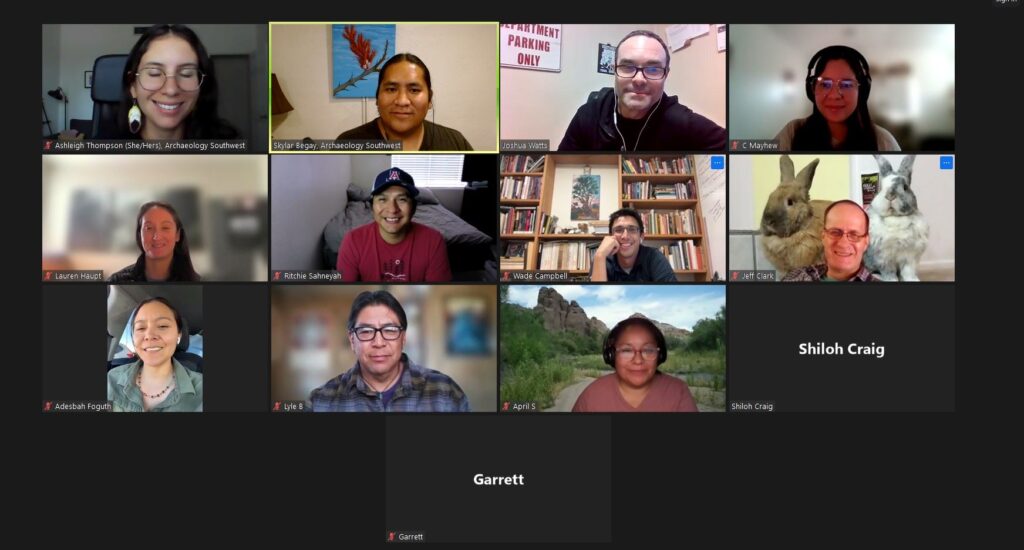 A screenshot from our most recent Tribal Working Group meeting where the newest members of the group were introduced!
A screenshot from our most recent Tribal Working Group meeting where the newest members of the group were introduced!
The cyberSW team includes:
Andre Takagi, Senior Systems Analyst/Developer
Ashleigh Thompson, Director of Tribal Collaboration in Research and Education, Red Lake Ojibwe
Bill Doelle, President & CEO
Caitlyn Mayhew, cyberSW Native American Fellow, Diné
Jeffrey Clark, ASW Preservation Archaeologist
Joshua Watts, cyberSW Manager
Sarah Oas, cyberSW Data Specialist
Skylar Begay, Director of Tribal Collaboration in Outreach and Advocacy, Diné, Mandan and Hidatsa
The Tribal Working Group includes:
April Sewequaptewa, Archaeologist, Hopi Tribe
Garrett Briggs, Archaeologist, Southern Ute Indian Tribe
Lyle Balenquah, Cultural Specialist and Archaeologist, Hopi Tribe
Patrick Cruz, Graduate Student, University Colorado Boulder, Ohkay Owingeh
Raquel Romero, Cultural Resource Division, Gila River Indian Community
Shane Anton, Tribal Historic Preservation Officer, Salt River Pima-Maricopa Indian Community
Wade Campbell, Assistant Professor, Boston University, Diné
We are happy to welcome the newest members of the Tribal Working Group!
Adesbah Foguth, Diné
Lauren Haupt, Caddo Nation
Ritchie Sahneyah, Hopi and Tewa
Shiloh Craig, White Mountain Apache
Wesley Miles, O’Odham, Diné, and Ndee
Closing Thanks
Across the country, Indigenous Peoples have been and are celebrating their collective heritages this November, which is Native American Heritage Month. This blog is meant to play a small part in celebrating this important month, but more importantly to show that Archaeology Southwest and the cyberSW team extend our gratitude to all members of the Tribal Working Group for sharing their time, energy, input, and knowledge over the past two years! We have learned so much from one another in our time together, and we very much look forward to continuing upon our collaborative journey with the new TWG members. We also extend a special thank you to those who contributed a few words to this piece. Happy Native American Heritage Month!
The post Looking Back, Looking Forward: cyberSW and the Tribal Working Group appeared first on Archaeology Southwest.




